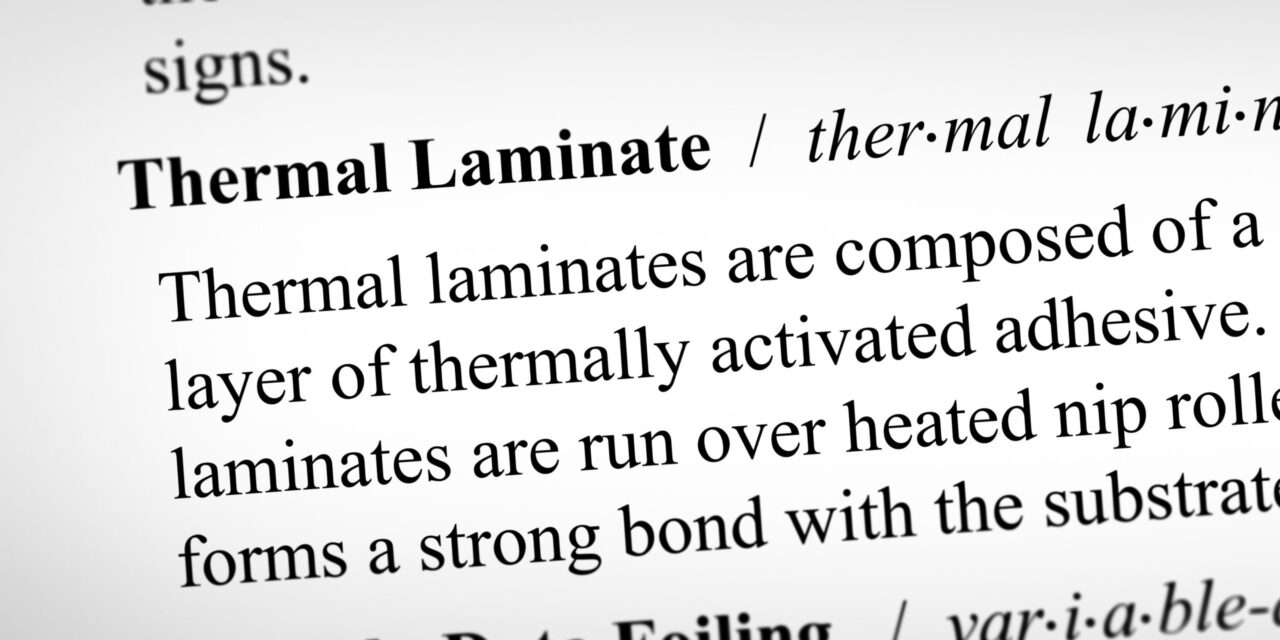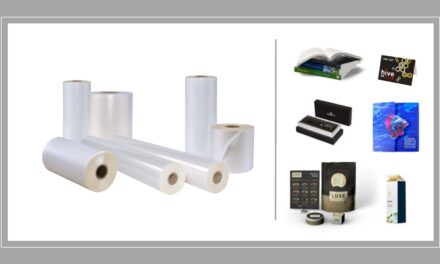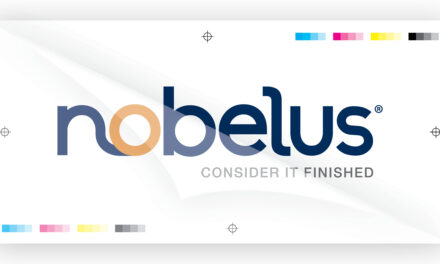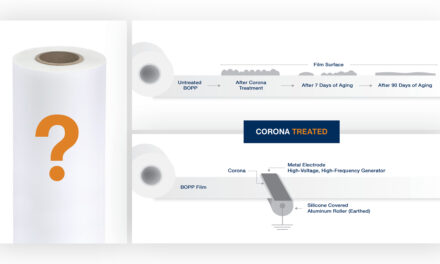A COMPLETE GLOSSARY, PART I: THERMAL LAMINATES
Lamination is a much more complicated process than many people realize, with a whole host of specialized materials, systems, and equipment. Whether you’re speaking with a sales representative or researching niche lamination facts online, it can be easy for important information to get lost in paragraphs packed with confusing lingo and industry-specific phrases. Drawing from decades of experience, Nobelus® aims to provide our customers and other curious readers with a comprehensive guide to some of the most common (and confusing) laminating terminology. This post primarily focuses on words related to thermal laminates. We’ve also included some Nobelus trademarked terms to help our blog readers as they peruse through our other posts.
THERMAL LAMINATION TERMS FROM A TO Z
TIP: To locate a term quickly, press ctrl and F simultaneously and then type the term in the search bar that appears.
ADHESIVE IN | ADHESIVE OUT
Sometimes referred to as A/I and A/O respectively, adhesive in and adhesive out are terms that describe the orientation of the adhesive layer on a roll of laminate. Adhesive-in rolls are wound so the adhesive layer faces the roll’s core. In contrast, adhesive-out rolls expose the adhesive layer on the outside face of the roll. The terms poly in and poly out can be used to convey the same concept.
BASE MATERIAL
The base material is the central layer of film in a thermal laminate, distinct from the adhesive and finish, and has an impact on everything from what applications the laminate is suitable for to which laminating equipment is most compatible. In the Nobelus portfolio, there are four base materials: polypropylene, polyester, nylon, and cellulose.
Learn more: How to Choose a Base Material for Thermal Laminating Films
BOAT WAKE
When very thick web is run through a laminator, the center of the web can sometimes be stretched while the edges receive less pressure. This issue distorts the surface of the laminated web and creates an effect that looks similar to a boat wake.
BOND STRENGTH
This term describes the strength of the bond between a thermal laminate and its substrate. Bond strength can be affected by a variety of factors, including ink type, adhesive quality, and laminating equipment maintenance.
BOPP (BIAXIALLY ORIENTED POLYPROPYLENE)
Sometimes abbreviated further as OPP, BOPP is a type of polypropylene film that has been stretched in two directions in manufacturing. This process makes it highly malleable and perfect for a wide variety of applications.
CLS | CELLO (CELLULOSE)
Unlike most laminate base materials, CLS laminates in the Nobelus Sustainable Collection are bio-based and made from PEFC-certified wood pulp instead of plastic. Thermal laminates made of CLS are typically paired with an EVA adhesive; for this reason, they are excellent for plastic reduction compared to other laminates but are not suitable for plastic-free applications.
COF (COEFFICIENT OF FRICTION)
COF refers to the measurement of a laminate’s surface tension and provides vital information about its tactility and machineability. The higher the COF, the more resistance the surface of the finish provides.
CURL
When a finished print bows up at the ends instead of lying flat, the effect is called curling. In almost every instance, this marks an issue in quality or production. Causes can range from mismatched material types to improperly calibrated lamination equipment.
DELAMINATION
Delamination refers to a quality issue where the laminate separates from the substrate after the lamination process due to either a weak bond with the printed piece or an error in the manufacturing process.
DIE CUTTING
This post-lamination process cuts out predefined shapes from a laminated sheet using a patterned metal die. It can be used to enhance design elements or create precise edges for pieces that will be used for folding applications, such as folding cartons.
DIGIBOND™ ADHESIVE
This specialty Nobelus adhesive is specifically designed for superior bond strength with challenging digital output, such as UV inkjet, dry toner, and fuser-oil based inks. It can be found on many different finishes and material types in the Nobelus catalog.
DOUBLE-SIDED LAMINATION
Double-sided lamination is the process of laminating a printed piece on both sides. The laminated piece may have edges that are cut flush with the substrate or be encapsulated for complete protection.
EMBOSSING
After a printed piece is laminated, embossing rollers can be used to create textures and visual effects to enhance design elements. Embossing is typically compatible only with softer materials as the roller must be able to apply adequate pressure to leave a lasting indent.
ENCAPSULATION
This is a double-sided lamination method where the laminate webs are cut at a set distance from the substrate, allowing them to meet and form a seal around the print. This is sometimes also called a sealed edge and is commonly for applications such as signage and menus.
EVA (ETHYLENE VINYL ACETATE)
The copolymer of ethylene and vinyl acetate, EVA is an elastic but tough material that is used as an adhesive in high-quality thermal laminates. This type of adhesive forms a strong bond with most aqueous inkjet, HP® Indigo, and conventional offset and flexographic presses.
FILM COMPOSITION RATIO
This term describes how much of a thermal laminate is made up of the film and how much is adhesive. For example, a 5 mil PET laminate may be composed of 3 mil PET and 2 mil adhesive.
FLUSH TRIM | FLUSH CUT
This term refers to the trimming of excess laminate from the edges of a laminated print so the substrate and laminate layers are flush. While this exposes the edges of the substrate, well-laminated pieces should maintain their bond so long as water does not seep in between the layers.
FOAMBOARD
Foamboard is a rigid substrate manufactured by placing a layer of inflexible foam between two sheets of heavy paper or cardstock. This substrate can vary in thickness and is heavily used for wide-format print mounting and signage projects.
FOIL BOARD
This metalized cardstock is typically more expensive than standard paper, but it enables craft enthusiasts and printers alike to give projects a metallic effect quickly and easily. See MET PET to learn how lamination can replicate this effect at a more affordable cost.
FOLDING CARTONS
Most everyone has seen folding cartons on store shelves with everything from beauty products to pet supplies stored inside. These containers begin as flat sheets of laminated paper that are then die cut and folded along printed lines to become thin but sturdy boxes in a wide range of shapes and sizes.
GCP (GENERAL COMMERCIAL PRINT)
GCP is an industry-specific category that includes most forms of commercialized printing with the exception of verticals that typically use narrow-web presses, such as prime labels and flexible packaging. GCP encompasses everything from books, magazines, and brochures to identification cards, folding cartons, and rigid boxes.
GLOSS FINISH
This shiny, translucent finish gives a boost to the colors of printed designs and brings an extra level of professionalism to standard paper. Gloss finishes are an essential option for many print services as they are a simple, cost-effective way to protect printed pieces without obscuring visual elements.
GLUEABLE/STAMPABLE LAMINATE
These laminates have a specialty finish with a chemical coating that is applied in the manufacturing process, allowing them to accept surface embellishments, such as foil stamping and most kinds of glue. Many finishes can accept similar post-lamination processes in certain conditions, but only glueable/stampable laminates are guaranteed to see success.
GLUING
In the thermal lamination industry, gluing typically refers to applying a cold glue with a protein base to products such as folding cartons. Hot glues may also be used, but the term ‘gluing’ almost always refers to the standard cold glue.
HOLOGRAPHIC FINISH
While many finishes reflect some amount of light, holographic finishes are specifically designed to refract light in a way that displays all the colors of the rainbow as the printed piece is turned and bent. This prismatic effect is extremely popular in markets that place high value on eye-catching displays and chic accents.
LAMINATE ADHESIVE RESIN
This is the layer in a thermal laminate that directly adheres to the substrate. Often constructed of EVA, an adhesive resin’s melting point enables it to soften when the laminate is pulled over a thermal nip roller and then regain structure once the laminated piece cools, forming a strong bond that should last through transport and frequent handling.
MAPPING & MATCHING
When thicker base materials, such as PETs, are used for double-sided lamination, they must be coupled with a laminate that is similar in its properties and thickness. Mapping and matching prevents laminated pieces from bowing or curling by ensuring the tension on both sides of the substrate is nearly equal.
MASTER ROLL
Also called a mother reel or mill roll, master rolls gather newly manufactured laminates into a neat roll right off the production line. These rolls must be slit to a more manageable size before the laminate can be run on a laminator.
MATTE FINISH
Ideal for designs that need a more muted look, a matte finish gives printed pieces a non-reflective, low-glare appeal. While most mattes will allow colors and small details to show through clearly, printers should verify that the finish’s tendency to soften images serves as a benefit to their application.
MIL WEIGHT
This unit of measurement describes the thickness of a laminate. One mil is approximately 1/40th of a millimeter; most laminates used for general commercial print range from 1 mil to 10 mil thick.
METALIZED LAMINATE
Metalized laminates enable printers to produce foil board in-house in an economical fashion using a paper substrate. Also called MET PET, short for metalized polyester, these laminates are typically made of PET and provide durability and advanced protection from moisture in addition to a shining metallic appeal for a broad range of applications.
MSI
A standard abbreviation for thousands of square inches, MSI is the most common unit of measurement used when buying and selling thermal laminates. The abbreviation comes from a combination of the Roman numeral M, which stands for one thousand, and the first letters of the words “square inch.”
NYLON
Used almost exclusively for laminating book covers, nylon as a base material is hygroscopic, which means it is highly resilient in humid settings. This characteristic helps book covers lie flat against the pages instead of curling outward over time.
OVERPRINTING
Any time ink is applied after the lamination process, it is called overprinting. This can be used to achieve complex designs, such as with variable-data foiling, or it may be necessary if the laminate is opaque as in the case of most metalized laminates and laminates used to make dark backgrounds.
PET (POLYESTER)
By far the most durable base material used in thermal lamination, PET is commonly used in applications that need structure and rigidity, such as identification cards or signage. It comes in a wide range of thicknesses but has limited receptiveness to post-lamination processes.
POST-LAMINATION PROCESS
Post-lamination process describes any value-add effects that are applied to a laminated piece after the laminate is bonded to the substrate. This can include anything from die cutting and folding to overprinting and spot UV.
ROUGH-TOUCH FINISH
Gritty with a light, sandy texture, rough-touch finishes are used to give thermal laminates a rugged haptic appeal that adds value to a printed piece.
Learn more: FineGrit™ Laminate: The Rugged Finish for Premium Brands
ROUNDED CORNERS
Thicker laminates are oftentimes given rounded corners in the lamination process to prevent sharper, thicker corners from harming the end user. In this process, an aptly named corner rounder is used to cut the laminate’s edge in a radius.
SATIN
This finish has a semi-gloss appearance that lies somewhere between shiny gloss and flat matte. Often used for applications that need a sophisticated appeal, it reduces glare on prints without being as muted as a standard matte finish.
SCUFF-RESISTANT FINISH
Unlike most thermal laminates, which are soft enough to scratch with regular handling, a scuff-resistant finish is manufactured with an acrylic topcoat that creates a truly scratch-proof barrier.
SILVER HALIDE REPLACEMENT (SHR™)
This process combines digital printing technology and thermal lamination to replicate the quality and feel of traditional silver halide photo production.
Learn more: Silver Halide Replacement: The Future of Photofinishing
SHIMLESS
A shimless laminate has no visibly repeating patterns, ensuring each laminated piece has a consistent appearance and reducing waste from discarded prints. This term is often used to describe holographic finishes with a seamless appearance.
SILVERING
This is a type of surface effect that occurs due to lack of pressure while applying thermal laminates. The result is tiny air pockets that are trapped between the surface of the printed piece and the adhesive of the film. True to its name, silvering causes a slightly hazy or silvery look on darker sheets.
SINGLE-SIDED LAMINATION
Single-sided lamination means that only the customer-facing side of a piece is laminated. This type of lamination is common with applications like book covers and folding cartons.
SLITTING
Slitting is the process of slicing a larger master roll of laminate into smaller rolls that can be used on standard laminating equipment.
SMUDGE-RESISTANT FINISH
Smudge-resistant finishes hide fingerprints, oils, and grease from regular handling to preserve the original visual quality of a printed piece. SmudgeProof Laminate, the smudge-resistant finish in the Nobelus catalog, couples this quality with a soft haptic appeal.
SOFT-TOUCH FINISH
Highly popular in the printing industry, thermal laminates with a soft-touch finish have a velvety soft texture that gives packaging and prints a luxurious, high-end feel.
Learn more: Which Type of Karess® Laminate Do I Need?
SPLICE
A splice is the location where two webs of thermal laminate are joined together on the same roll as a result of a master roll change during the manufacturing process.
SPOT UV
Spot UV is a post-lamination process that uses ultraviolet light to cure the topcoat of a laminate in targeted areas to create a variety of smooth, shiny designs.
SUBSTRATE
This is the layer over which the thermal laminate is applied in the laminating process. A substrate can be made of paper, plastic, fabric, or a variety of other materials.
STAMPING
In traditional foil stamping, pre-cut metal dies are used to press down firmly on a foil web laid overtop a laminated piece. This pressure forces the foil down into the laminate’s surface to create detailed metallic designs.
THERMAL LAMINATE
Thermal laminates are composed of a thin film layer coupled with a layer of thermally activated adhesive. In a laminating system, thermal laminates are run over heated nip rollers so the adhesive layer melts and forms a strong bond with the substrate.
VARIABLE-DATA FOILING
Variable-data foiling is a type of post-laminate process that enables printers to change elements of the design for each printed piece using a digital press and foil that sticks to the exposed ink. This embellishment is used mostly for invitations and other on-demand print jobs. The Nobelus Sleeking® method uses a variation of variable-data foiling.
WEB
Any thin, flexible material used in the laminating process is called a web. This can include substrates, thermal laminates, unsupported films, and foils.





